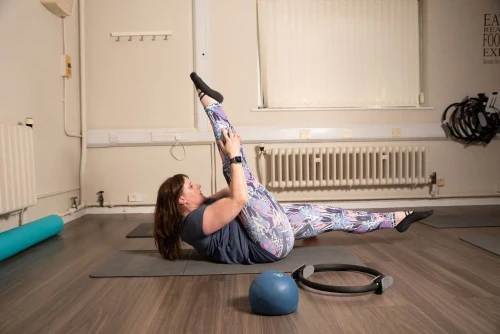Whether you are an athlete or you occasionally workout, tight hamstrings put you at risk of hamstring injury and back pain.
By making a few changes to your daily routine, you can help reduce your risk of hamstring injuries:
Static hamstring Stretching
Static hamstring stretches can be effective in releasing tension and increasing flexibility:
-
Standing hamstring stretch: Stand facing a chair and lift one leg so the foot is on the chair seat. Then, with your chest and back straight, bend forward at the hips until you feel the stretch in your hamstring.
- Seated hamstring stretch: Sit so the knee of your right leg is bent and the bottom of your right foot is pressed against the inside of the left thigh. Stretch out your left leg ahead of you flat on the ground, and slowly lean down toward your left foot.
Dynamic hamstring stretches:
Dynamic stretching should be done after the muscles are warm. These stretches are slightly more intensive as you are adding some movement to the stretches.​​​​​​:
- Straight leg toe touch: Stand straight up, hold your arms out in front of you and swing one leg up towards your hands, and then back behind you. Repeat 10-15 swings on each side.
- One-leg bird stretch: Start with an upright posture, then lift one leg straight behind you as you bend forward at the hips and try to touch your toes. Hold this position for a few seconds and then release it.
Pilates
Pilates is a proved and effective way to condition the body and support the muscles closest to the spine, therefore helping to stabilise the core and prevent injury or pain. Pilates is a great way to incorporate a regular stretching routine into your life.
Protect your back
Stretching your hamstrings will not only improve the flexibility of your hamstrings, but it can lower the chances of back injury and pain.
Balance your muscle strength across your body
Many people work hard on their hamstrings but ignore the other muscles around them, which can then cause hamstring problems. As well as increasingly flexibility, it's important to have a good balance of strength across your different muscle groups:
- Stretch your quadriceps: Place your right hand against a wall and take the left hand and grab the left foot while bending your knee. Align your knees and tilt your pelvis forward as you pull up your left foot behind you. Hold for 30 seconds.
Learn about your body
Consider speaking to a PT or Osteopath for guidance on the right exercises or stretches to help with your muscle strength and conditioning. Their expertise will help ensure you are training in the right way to prevent injuries.
Warming up
As cliché as it sounds, always devote several minutes to stretching before any exercise in order to decrease your risk of hamstring injury. This is especially important if you have had hamstring injuries in the past. Warming up will help get the blood flowing through your body and increase your heart rate. Allow extra time for a warm up if the weather is colder.
Cool down
After exercising you should cool down with either light aerobic exercise or stretching. A good cool down stretch involves sitting down with your back straight and your legs out in front of you. Reach down towards your toes with both hands, hold for ten seconds, release and repeat.
Weight
People who are overweight have increased stress on their leg muscles and joints, which can then lead to a higher risk of injury. Sustainable weight loss management should involve making heathy lifestyle changes…not extreme dieting.
Stay hydrated.
Drink plenty of water during the day as dehydration can actually lead to muscle cramping, which increases the chances of muscle injury…and other health conditions.
Healthy balanced diet.
In order for your muscles to be healthy, they need to be looked after with a healthy balance of the right nutrients and minerals.
Stay active
Doing regular exercise will help keep your body in good shape and increase the strength and flexibility of your muscles. This in turn helps to reduce risk of injury. Even just taking a short walk during the day can help reduce your risk of injury.
For any help or advice please do contact us directly

